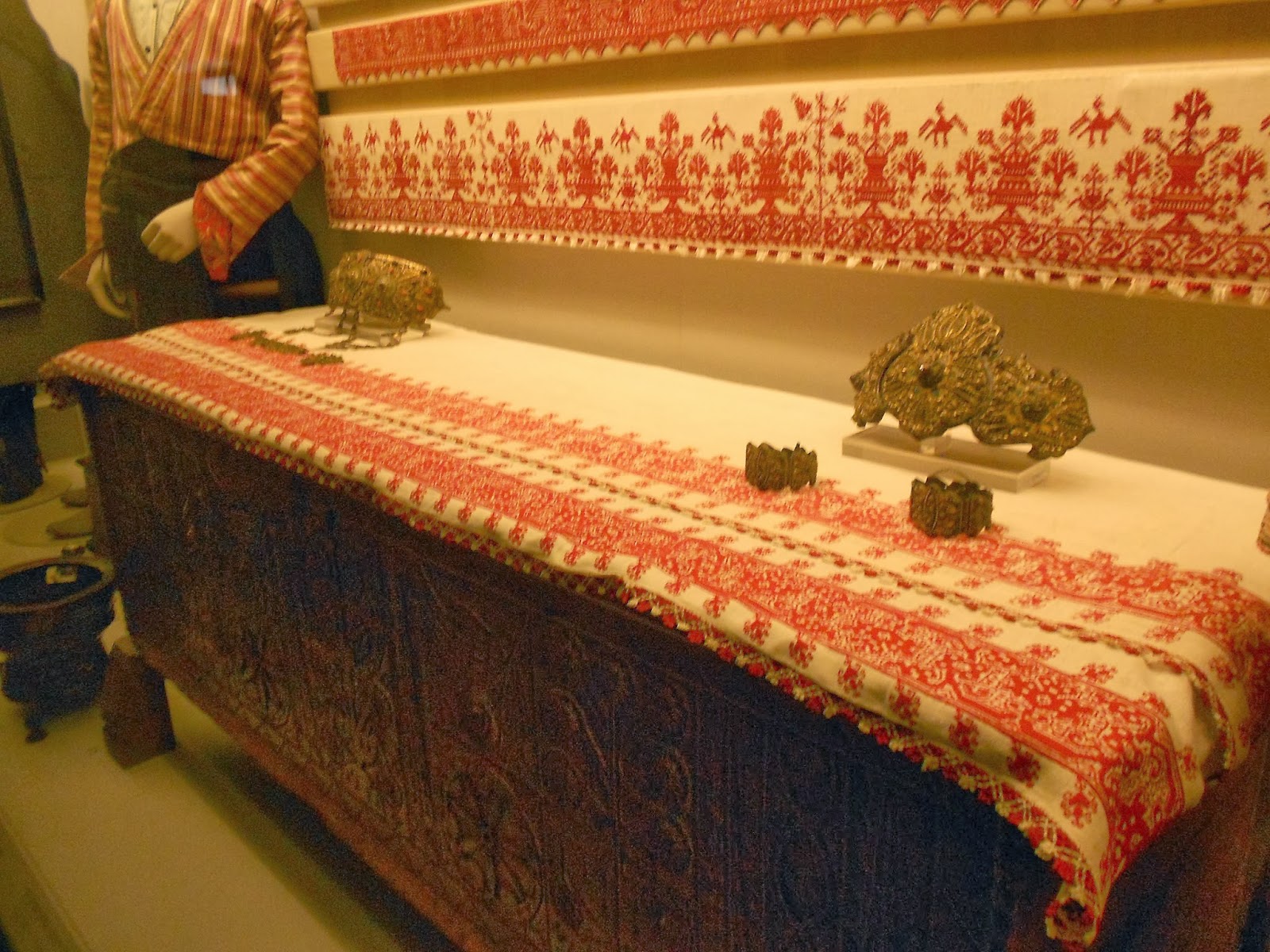Textiles and embroidery are a very important part of Greek culture. The Benaki Museum has an impressive collection of textiles and costumes.
Fragment of a linen tunic band decorated with a grid pattern of lozenges and medallions with symmetrical motifs. Egypt, 8th Century BC.
Linen and woollen screen curtain using the loop-weave technique, with the representation of a praying couple. Antinoe, Egypt, 5th - 6th Century BC.
Tapestry medallion of linen and wool from a wall hanging, representing Pegasus. Although the subject is borrowed from Greek mythology, the decorative details reveal a Sassanian influence, 6th Century BC.
Parchment lectionary of the Gospels bearing the name of the scribe, the monk Theodosius. The full page depiction of St. Luke and the ornamental headpiece with the impressive initial capital are contemporary with the manuscript.
White embroidered linen cloth, a covering for the Holy Altar, with a representation of Christ as the Judge of the Apocalypse, framed by the Virgin, St. John the Baptist and angels. Dalmatian or German workshop, 15th Century.
Female costume, a rare survivor of a type of costume that had its origin in a Western Renaissance style and was to be in the Aegean Islands during their occupation by the Franks. Crete, 17th Century.
Parts from embroidered hems of female costumes from Crete with double-headed eagles, flower vases, birds, mermaids and vegetal motifs, 18th - 19th Century.
Red monochrome embroideries for bedecking the bridal bed. From Cyprus, 18th Century.
On the left with an orange skirt and black jacket is a female urban costume of Cyprus.
In the middle is a chemise with raised embroidery, from Karpathos, Dodecanese, 18th Century.
On the right is a bridal costume from Astypalaia, Dodecanese.
Female festive costume from Kalymnos, Dodecanese.
Borders of embroideries from Pholegandros, Cyclades
Borders of polychrome embroideries from Siphnos, Cyclades, 18th - 19th Century.
Embroidered bed valances, examples of Cycladic needlework from Anaphi. They are distinguished by the pronounced stylization of their decorative motifs. The bed valance that bears a frieze with repetitive female figures between trees with birds and deer is one of the earliest examples, 17th - 18th Century.
Embroideries from the Cyclades, 18th - 19th Century. Two white embroideries from a valance and a sheet. Represented on the top white embroidery are female figures on horseback, led by other females holding flags. On the other white embroidery female figures alternate with winged griffins, ships with sails and eagles. The polychrome valance is from Ios, embroidered with peacocks, deer and flowers.
Bedspread from the Cyclades, 17th - 18th Century. Embroidered all over with a geometric design.
Bedspread from Crete, late 17th - early 18th Century. Embroidered all over with vegetal and flower motifs, birds and heraldic animals. This bedspread is a rare, if not unique, example of what formerly adorned the bridal bed in Crete.
Central panel of a sperveri, from Patmos, Dodecanese, 17th - 18th Century.
The central opening of a gold thread embroidered tent from the bridal bed. Small stylized human figures appear amidst a host of decorative motifs, while at the top is depicted the age-old subject of the woman at the window of her home.
Woven sheets from Crete, 19th Century. Dense loom-woven embroidery with geometric motifs in vivid colours. Outstanding among them is the example with a representation of dance.
Wooden carved loom from Crete, early 19th Century.
Sperveri from Rhodes, 17th - 18th Century.
A rare kind of tent that isolated the sleeping platform from the lower sitting area and hid the bridal bed from prying eyes. This is the best preserved and most spectacular of the few comparable surviving examples from the Dodecanese. The polychrome vegetal motifs, flower vases and peacocks are worked in the Dodecanesian raised stitch. Its workmanship combines sumptuousness of style with excellence of execution, austere compilation of an overall pattern with echoes of Byzantine splendour and Neo-Hellenic aesthetic orientations.
Edge of an embroidery from Asia Minor, with a pattern of cypress trees, tulips and facing birds, 18th Century.
Bridal sheet and cushion from Ioannina, Epirus, 18th Century. The borders are embroidered in a continuous frieze with a repeating motif of a flower vase flanked by two male figures. The same motif is embroidered on the cushion.
Bridal bed valance from Ioannina, Epirus, 18th Century.
The five ieces of the valance are densely embroidered with towers, human figures, boats, flower vases, peacocks and other birds, double headed eagles, flowers and plants. The composition of the has undoubtedly a narrative, though indistinct, content.
Bridal cushions from Ioannina, Epirus, 18th Century.
One represents the bride on horseback between her parents and two horsemen. Another depicts the mounted procession of the groom and the bride and her parents in the centre. The two embroideries are framed by six smaller ones with flowers and human figures. The narrative and painterly qualities of the compositions are characteristic of Epirote embroiderly.
Embroideries with heraldics peacocks, double headed eagles, birds, deer and small animals. They are characterized by the stylish decoration and the variety of motifs. From Lefkada, 18th Century.
Bridal costume of Ayia Anna, Euboea
Female festive costume from Atalanti, Eastern Central Greece.
Centre, bridal costume from Arachova in Phokis in Central Greece, constituted from various costumes.
Bridal costume from Tanagra in Boeotia, Central Greece, reconstituted from various garments.
Centre, Bridal costume from Attica.
Rare bride costume known as "golden attire", which was worn in the villages of Attica after the liberation of Greece from the Turks.



































































No comments:
Post a Comment